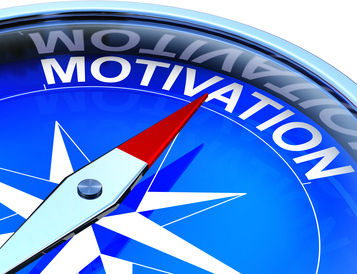Do you easily stick with your nutrition plan or do you give in to unplanned cheating and frequent excesses? Do you have near-perfect gym attendance or do you often skip workouts? When you do workout, are your sessions a 10 out of 10, or do you have a lot of 6’s and 7’s (or lower)? Have you ever weighed the consequences of those missed or sub-par workouts? Did you ever add up the calories from all those indulgences or see how one weekend can erase an entire week of work? Here’s a big question to ponder: What would happen to your results – the increased amount of fat you would burn, the muscle you would build, the strength you would gain – if you finally mastered this whole “fitness motivation” thing and finally STUCK WITH YOUR PROGRAM without falling off the wagon again… [updated]
 There are countless factors that increase motivation, but I have a strong opinion about what I believe is the most important factor of all – the ultimate key to sticking with it, all the way to a full-fledged physique transformation.
There are countless factors that increase motivation, but I have a strong opinion about what I believe is the most important factor of all – the ultimate key to sticking with it, all the way to a full-fledged physique transformation.
After more than 20 years of using this method, I’m a believer
I’ve used this motivational force with success for many years. I’ve always taken it seriously and built it into all my training and coaching programs. Here are some of the ways:
When my clients knew they were going to be weighed and measured every week, they worked harder during the week in anticipation of the big Monday… weigh-in day!
I also created a 12 week progress chart that measured body weight, skinfolds, body fat percentage, lean body mass, fat body mass, waist measurement, and the change in each measurement from week to week. Naturally, of course, we took “before” photographs as well.
My local coaching clients met with me in person where they would step on the scale and I took their body fat measurement with calipers. We recorded these results on paper and then took a look at the progress and talked about the results. Based on results, we would decide whether any adjustments needed to be made and we set new goals for the following week… in writing.
We wrote down the goal on a copy of the progress chart in red ink – it was filled-in in advance as if it were already achieved. My clients would post this chart with the results up to date and the weekly goal on their refrigerator where they would have to look at it at least few times a day. Many of them also wrote a new goal card every week with their 12 week goal and their 1 week goal written on it.
For my internet or phone clients, every Monday morning, my clients would email or fax me their progress chart and sometimes even their entire eating and training diary for the previous 7 days. If they knew I was going to be looking through their journal like a professor at a term paper, I knew they would be sticking with the program better.
The progress chart was held sacred. Seeing those numbers on paper was incredibly enlightening due to the way you could see progress in a linear fashion over time. Everything became tangible too. You could hold the piece of paper. It was your report card. It was real.
Did you ever notice how if you had straight A’s on a report card it just drove you mad if you had even a single B on it? Well, I always noticed how my clients never wanted to have a “blemish” on their weekly progress chart. They almost always worked harder knowing this measuring, charting and tracking was going to happen.
On the occasions that people cancelled a session, I always probed into the reason why. Some were legit, most were excuses, but one thing I always noticed is that if someone had a bad week, they wanted to “dodge me” and cancel the weekly measure & weigh-in meeting.
Like I said, they hated having a blemish on that chart or even worse, facing their coach in person without having results to show for the week’s efforts. This is why I liked to stay in touch with them by phone and email throughout the week and confirm my appointments in advance. This keeping tabs on them decreased cancellations and kept them motivated and on track during the week.
Simple motivational concepts, yes, but the results were amazing and the power behind these psychological principles is undeniable.
If you haven’t guessed already, the word for this motivational force I’ve been describing – the weighing, measuring, tracking, keeping tabs and so on – is of course, ACCOUNTABILITY.
This probably resonates with you because you might remember times when you put accountability into action in your life and you were highly successful and produced results at a high level.
Now, I have two questions:
1) Are you currently using accountability to help you stick with your program?
2) If you are currently using accountability, did you ever think about the power of having a multi-level “accountability SYSTEM”?
If you’re not using accountability right now in your nutrition, training and healthy lifestyle plan or if you are and you’d like to learn how to multiply accountability by a factor of 4X, please read on.
Level One: Self accountability
Accountability is a MASSIVE leverage factor in achieving any kind of success, whether in business or in a fitness program and here’s where it starts: with yourself. Self accountability, also known as internal accountability is very simple: It means you set a goal, map out a plan, make a commitment to it and then KEEP SCORE.
You can become accountable to yourself by:
1. setting written goals
2. weighing yourself
3. measuring body composition
4. taking body (circumference) measurements
5. taking photographs
6. Creating menu plans or tracking nutritional intake in a journal
7. Creating workout schedules and tracking training performance in a journal
Basically, anything you want to improve should be measured and everything related to your nutrition, training and even lifestyle (hours and quality of sleep, etc) should be tracked in writing (or electronically).
If you aren’t keeping track and staying accountable by using at least 6 out of 7 items in the list above, then this is where you begin.
Level Two: Accountability to another
No one is coming to your rescue. Change starts with you. “If it is to be, it’s up to me.” You have to make that important self commitment. But once you’ve accepted personal responsibility, you can literally double your motivation with this second step. All you have to do is take those journals and written progress reports and show them to an accountability partner on a weekly or even daily basis.
Your support partners could be anyone – friends, family, siblings, neighbors, co-workers or even your internet friends from forums and social networking sites. You can also recruit a professional – a coach, trainer or mentor of some kind. Get your partner’s agreement that he or she will hold you accountable for the daily action steps you must take and the weekly goals you want to achieve. They have to hold you to it or they’re not real accountability partners. No “Yes men” for this job.
If you have access to your support partner in person, you can increase the positive pressure a bit by having your partner take your picture, weight, body fat and measurements rather than you taking your own.
Why is this so effective? Well, have you ever heard the saying, “Performance is improved when performance is measured?” It’s a popular maxim in business management circles. Good managers have found that personal productivity can be increased many times over by measuring and tracking anything and everything, sometimes to the extent of having employees use numerous checklists, reports and even a diary of how they spend their time.
Rest assured, it works in fitness even better than in business.
Level three: Accountability to a group
Social psychologists have studied group behavior for the better part of a century. Crowd behavior has some interesting dark sides, many of which are far worse than the problem of conformity. But I believe the bright sides of a positive group are stronger and more powerful.
Not only do all human beings have a deep seated desire to belong and to socialize with like-minded people, there’s a group dynamic that creates a powerful positive pressure that can be applied toward higher levels of achievement. You can take advantage of this positive pressure and social support by joining the right groups.
When discipline is imposed externally and high expectations are set within a group, things get done at a high level. There is also an ego factor involved, (or simply call it an extra “motivational factor”), that makes you want to push harder when others are watching. It’s even more powerful if there are real consequences, either emotional or physical, for not fulfilling the expectations. You could call it the “Drill sergeant” effect.
Speaking of military metaphors, look at how Boot camp classes and group personal training are more popular than ever before. Consider the leverage that’s created when you make yourself accountable to a whole group instead of just one person. Not only is your “drill sergeant” instructor watching you, you also know that your peers in your group are watching you. What happens if you stop short or quit in front of everyone? Does the prospect of pushing your self harder seem more likely?
Think about support groups where participants gather around a table or in a circle and must share to the entire group how their week went. What are the emotional consequences of falling behind? Amazingly, this works almost as well online in virtual groups as it does in person and ongoing research has continued to confirm that.
Accountability partners and support groups will always pull more out of you. A coach, partner or group will help you raise your standards and see the potential in you that you didn’t even know you had. After working with any truly effective coach or support group, you will realize that you have been thinking too small and selling yourself short. A group will lift up that positive pressure to a level you never imagined before you immersed yourself in that environment. But it’s possible to take this even further. How?
Level four: Public accountability
GO PUBLIC! By announcing your intentions and posting your results for all the world to see, you add a fourth tier of accountability, that for some people, cinches the deal to the level of FAILURE IS NOT AN OPTION. Why? Because look at the alternative. Losing face.
A great example of going public is the story of my friend, Australian fitness blogger Adam Waters.
After several frustrating attempts to complete various physique transformation contests, Adam was sick and tired of being, sick and tired… and fat. He decided that as motivational as these transformation contests were, he knew there was another level.
He decided to put the power of accountability to work not only by using ALL four levels of accountability, but also by taking his photograph every day and posting it on the web for all the world to see.
The results made him famous. His story has been featured on TV, in Men’s Fitness (Australian and US editions) and his real time physique time lapse video has had more than 7,000,000 views on you tube – along with the #1 you tube search ranking for “weight loss.”
To Adam though, all the attention was just a side benefit. The real benefit was that he beat body fat once and for all. He went from (in his own words) sick, fat and stupid, to six pack abs, happy and successful. And then he went on to help other people do the same.
He credits his success to accountability. In his case, “real time internet accountability.
I hope you are now seeing the potential in this force for helping you get the body you deserve and you will print out this post, read and re-read it, soak in the information about the four levels of accountability, and start to apply it in your life .
Share it with others too, because the higher levels of accountability all involve other people. You have to do it by yourself, but you can’t do it alone.
– Tom Venuto
Author of Burn the Fat, Feed the Muscle
Learn more about the power of accountability and social support in my free ebook, “The 5th Element: Missing Piece of the Fat Loss Puzzle: http://www.burnthefatinnercircle.com/5th
Tom Venuto is a natural bodybuilder, fat loss coach, fitness writer and author of Burn The Fat, Feed The Muscle. Tom’s articles are published on hundreds of websites worldwide and he has been featured in Muscle and Fitness, Men’s Fitness, Oprah magazine, The New York Daily News, The New York Times and the Wall Street Journal. He has appeared on dozens of podcasts and radio shows including Sirius XM, ESPN-1250, WCBS and Day Break USA. Tom is also the founder and CEO of the premier fat loss support community, the Burn The Fat Inner Circle.








G’day Tom,Wow! Your post really encapsulates the full power of harnessing the motivational force of “positive pressure” via a multi-layered Web 2.0 accountability approach
Hey Tom,you are so very much right with every word you said. Adam is very much inspirational with his own story.I am now 20 days in the program and it is simply unbelievable. It is difficult to fall off the wagon and if so: You com back, jump on the horse and ride on.The atmosphere of positive pressure is simply fantastic, effective and working. Not only for me but for so many other people as well. year!Massive!If I sound too excited: I am sorry for sounding like a little teenage-girl but I am happy that I found a program whch is so good and simply so much fun. No lies, no thrills, no negativity, only positive pressure.I am proud to be a Shredder, and YES, Tom, this force is massive and the contest is OFF THE RICHTER!Juli
Hi Tom, I can attest first hand to the incredible power a community has on one’s motivation when they are looking at a fresh set of your pictures every day.Your brilliant article will, I’m sure help people to understand and buy into the power of accountability and will assist everybody who is competing in this challenge to get the absolute best out of the next 84 days. I am a longtime owner of BFFM and just want to thank you for all your incredible work as a health and fitness professional working to help people beat this dreaded epidemic,obesity.
Word! I only stay on target when I have a written account of everything I put into my mouth and every.single.bit of exercising I do. Two weeks ago, I started to post my inches lost/miles run/lbs lifted online so that I am accountable to each person who visits my blog. Like you said, now that I know folks are watching, I have to keep my butt moving!
Not only can I comment that the above accountability is true, but I can comment from a standpoint of 18 years of bodybuilding myself that keeping it simple and accounting for your efforts is the absolute best way to reach any goal. Great post Tom.
This looks great, but how much weight can be safely lost in the 84 days? i am around 290 and want to get to between 200 and 225 (i think i will be skin and bones below 200, but i don’t know) and then go from there. Also, i don’t have a gym membership and have access to a small workout area with barbells and a bench. How many of the exercises could i do and still keep shredding? Could my wife also do the program with me? She is in better shape than i, but still has a few stubborn pounds that won’t go away. Thanks.Mike C.
I lost 20 pounds due to accountability, in my office. I had one year to lose 30 pounds, or I would do the graveyard shift… on New Year’s Eve… WITHOUT PAY!Since I lost only 20 I did the shift, BUT some wonderful things happened:1. I was not paid, as agreed, but they took that money and bought me a one year subscription to a weight loss program, to continue my journey.2. They challenge started on 2007, but I am still being weighed weekly, to maintain my weight. And all weigh-ins are written down for everyone to see.3. I ended inspiring others in my office to loose weight. Most also get weighed the same day I do and have their weight written down. One coworker has already lost 50+ pounds!
Great post as always! (long time follower, first time poster)The problem with 18 yr olds these days though is that most of us don’t realize what a shame it is to waste what is arguably the best time in our lives to get fit by eating junk all the time, hardly training and (in Australia) excessive drinking. So being a former fat kid myself (That weighed in at 112kg last Jan and is 84kg now; 33->15%), I must admit, it can sometimes be a case of it getting harder to stay motivated once you’re fairly fit than it was when you couldn’t run 400m.Which is why, ironically, I always try to motivate my friends (boys and girls, regardless of fitness levels) to better themselves even though most of my friends (and family, sadly) always call me “obsessed” and “OTT” because I train 5 times a week and I’m always eating a grilled kangaroo/chicken or tuna salad.So Tom, thanks so much for taking the time to write about an issue that I think is very underrated, but even moreso for giving those of us with ‘lazy’ friends (even the naturally lean ones that could do better) a way to create our own accountability. I will have to check my calendar and see how many exams I’ll have during this period (1st year at uni) so i really have to ‘weigh up’ my options/consequences… but that aside I think I’ve never been more excited for joining a comp in my life!!!
I have kept myself accountable by joining http://caloriecount.about.com and tracking my caloric intake and weight loss since just after I broke my big toe around St. Patrick’s day. It has been a huge motivated and kept myself accountable to myself and made me aware of the bad decisions I may have made with food. after 1 month, I want better results so I joined a gym and my girlfriend is keeping me accountable as well.
I have kept myself accountable by joining http://caloriecount.about.com and tracking my caloric intake and weight loss since just after I broke my big toe around St. Patrick’s day.It has been a huge motivator and kept myself accountable to myself and made me aware of the bad decisions I may have made with food. after 1 month, I want better results so I joined a gym and my girlfriend is keeping me accountable as well.
September 2005 I had to take early retirement from my science job at the age of 57. My muscles had been destroyed by Statins and I was 3 times the recommended levels for cholesterol even ON statins. I was stressed out, asthmatic, pre-diabetic, weighed 245 pounds and doctors said I would be dead in 6 months if I did not change.I retired to a rural property, started eating healthy home cooked meals and started exercising by walking, painfully, for 15 to 20 minutes. I bought “Burn the fat feed the muscle” and was aghast. No more “dieting” just eating correctly. I weighed and blogged every day and had my husband take photos every month plus measurements every week.I lost 70 pounds, could walk 10 kilometers happily. Went back to the gym using free weights mostly and astounded the men there by how much I (an “elderly” female) could squat (90 kilo) and bench press (50 kilo) again. I had done bodybuilding for fun, no competition, for 16 years before I made myself sick.I was no longer pre-diabetic, my cholesterols were just above normal with NO medication and my muscles had regenerated.HOWEVER, I got complacent, and gained back 20 pounds in the last 12 months. I have a job again that is shift work, not in science, and unable to get to that weight gym now. I only work out at home with dumbells and pulleys, racewalk for fun and take the dog on daily 5.5 Km walks.This has nudged me out of my compacency and I know I need to lose that 20 pounds and another 20 in order to get into sexy dresses instead of trousers and shirts. being 61 is NO excuse for being this lazy person I have become.SO, weigh and blog daily, measure weekly, exercise to above the best of what I think I can do, and most of all BELIEVE I can do it.Thank you, this was timely for me.
You know I must be strange and the odd one out but when I decided to clean up my diet and remove all the junk, I did so knowing it wasn’t good for me. Fat loss was one aspect but the fact that this rubbish is BAD for you. When it comes to so called “cheating” I really don’t understand the necessity for it. I don’t consider it cheating, I consider it foolishness. BTW I have NO cravings for junk or rubbish food and scarcely notice when someone cuts a birthday cake or offers candy. I have 3/4 of a block of very dark sugar-free gourmet chocolate that I have had for 6 months now and am happy to let it sit in the fridge. I think you are creating dangerous eating disorders by planning to cheat next week and building in your head and then gorging on rubbish.Just my 2 cents worth.Thanks for the posts, keep up the good work.
Great article Tom. I would like to see more articles such as this that tackle the psychological aspect of fitness and nutrition adherence. If your interested in the scientific research applying to food consumption check out Brian Wansink.thanks,Jamie Hale